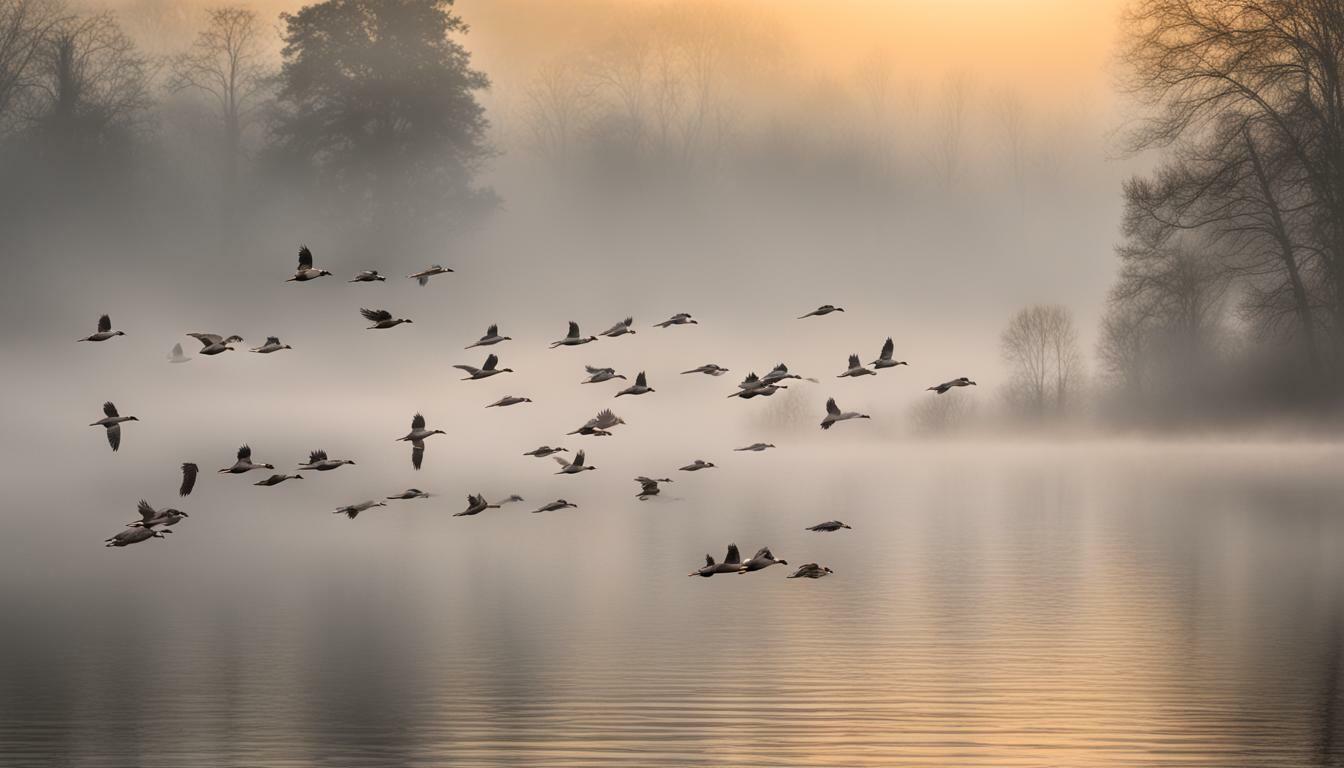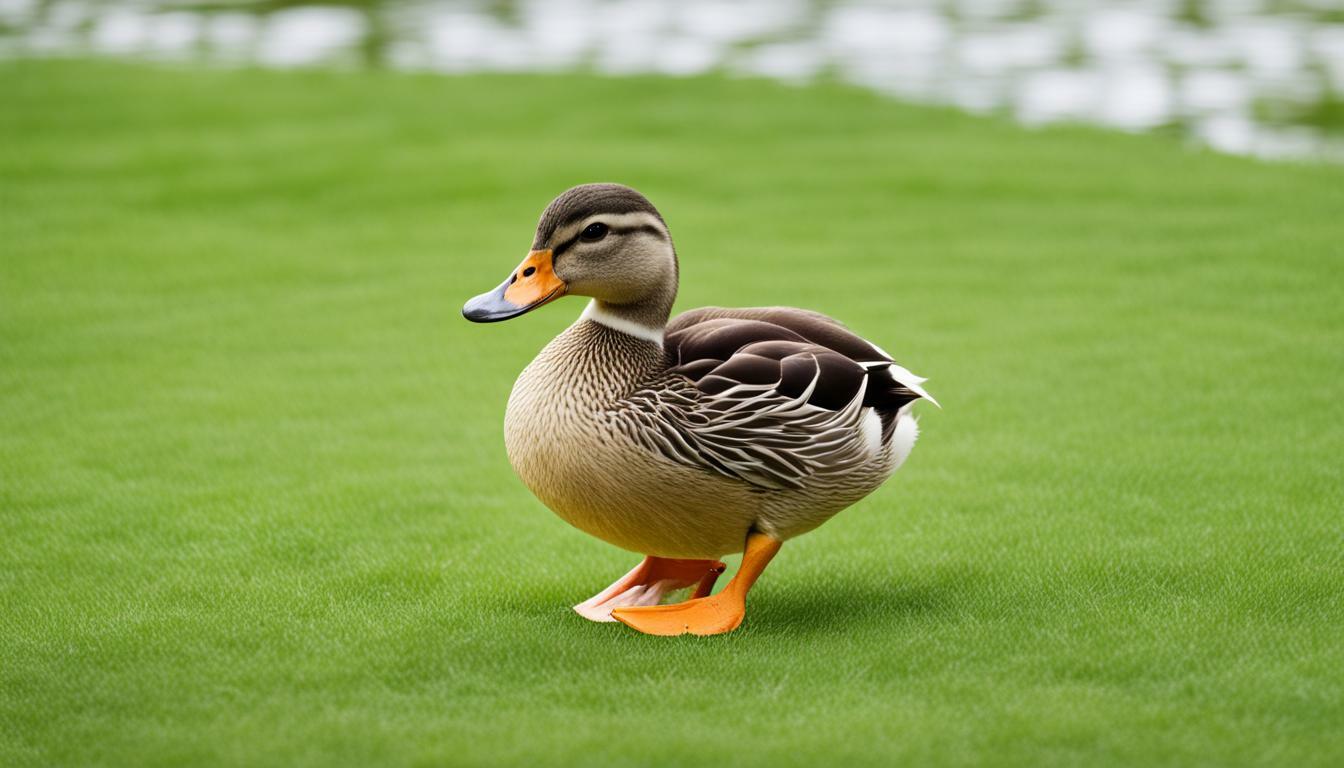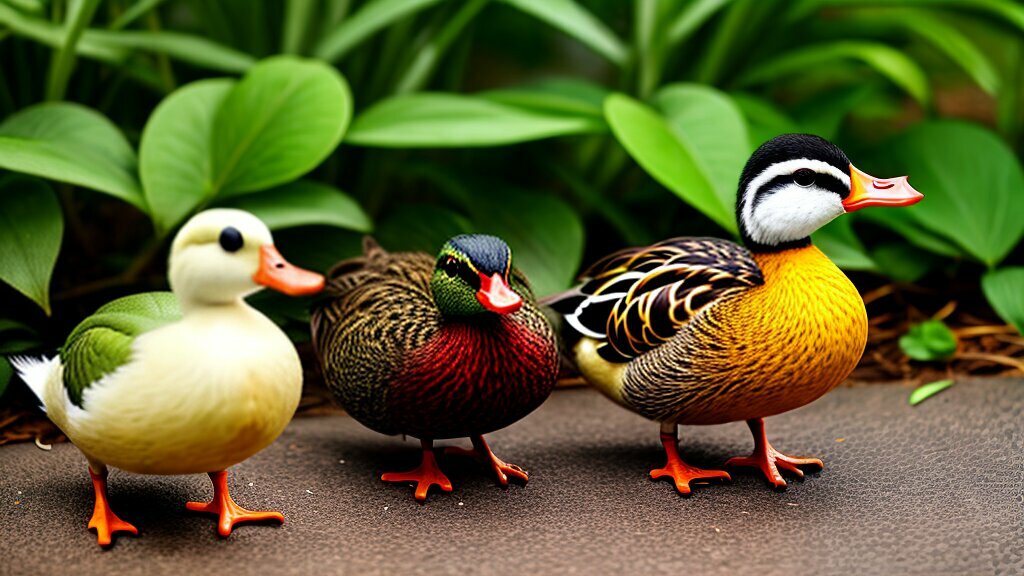How Do Ducks Fly and Navigate in Foggy Conditions?

Table of content:
- How Fog Impacts a Duck’s Ability to Fly and Navigate
- Special Duck Adaptations for Flying in Fog
- Duck Flight and Landing Behavior in Foggy Conditions
- Risk of Ducks Getting Lost or Disoriented in Flight
- Duck Migration and Fog Weather Patterns
- Duck Eyesight Versus Human Vision in Fog
- Non-Visual Duck Navigation Aids in Fog
- How Duck Eyesight Compares to Other Birds in Fog
- Conclusions
Fog can create hazardous flying conditions for birds. Thick fog significantly reduces visibility and can obscure visual landmarks that birds rely on for navigation. However, ducks have evolved adaptations that allow them to take flight and orient themselves even in the thickest fog.
How Fog Impacts a Duck’s Ability to Fly and Navigate
Fog forms when the air becomes saturated with tiny suspended water droplets. This creates an optical phenomenon that scatters light and severely limits visibility.
Dense fog can reduce horizontal visibility to less than 1/4 mile. This can make it difficult for ducks to see obstacles in their flight path or familiar landmarks used for navigation.
Unlike humans, ducks have excellent low light vision. Their eyes are particularly adapted to seeing in dawn and dusk conditions. However, even a duck’s visual acuity has limits.
In foggy conditions, the tiny airborne water droplets scatter and diffuse light in all directions. This creates an illuminated veil that obscures and distorts objects even short distances away.
While a duck’s eyes are specialized for low light conditions, they cannot penetrate dense fog any better than human eyes. As a result, ducks must rely on other senses besides vision for flight and navigation when visibility is poor.
Special Duck Adaptations for Flying in Fog
Ducks possess several key adaptations that help them take flight quickly and navigate accurately even in the densest fog:
Excellent Hearing – A duck’s hearing is extremely sensitive compared to many bird species. They can detect sounds at much lower thresholds thanks to specialized structures in their inner ear. This allows them to listen for obstacles or familiar landmarks in fog.
Keen Sense of Smell – A duck’s olfactory senses are highly developed. They have a large number of odor receptors in their nasal cavity and brain. By smelling landmarks like rivers, forests, or agricultural fields, ducks can navigate in fog when visual cues are obscured.
Magnetic Compass – Ducks can detect magnetic fields thanks to deposits of magnetite in their brains. They use an internal magnetic compass to maintain their bearing even when celestial guides like the sun are obscured by fog.
Powerful Wing Muscles – Ducks have strong pectoral muscles for takeoff and flight. This allows them to rapidly gain altitude and get above fog layers to restore visibility. Their muscular power gives them great maneuverability to avoid collisions.
Water-Repellent Feathers – A duck’s feathers are coated in oils that cause water to bead up and roll off. This prevents fog droplets from saturating their plumage and reducing maneuverability.
Duck Flight and Landing Behavior in Foggy Conditions
When fog rolls in, ducks will alter their flight patterns and landing behavior to compensate for reduced visibility and hazards:
- Ducks will flush and take flight more frequently when fog sets in. Taking to the air improves visibility versus a ground-level perspective.
- Low-altitude flight is more hazardous in fog. Ducks will rapidly climb to get above the fog line whenever possible to re-establish visual navigation.
- Landings become more cautious in fog. Ducks will circle lower while listening and looking for familiar landmarks before descending.
- Open water landings are avoided. Wave noise and reflective surface make foggy water landings highly risky. Ducks will delay landing or seek shore instead.
- Penetrating fog risks collisions. Ducks delay entering extremely dense fog banks that completely obscure visibility.
- Sudden descent and collision avoidance are more frequent in fog. Ducks employ emergency maneuvering when encountering unseen obstacles.
Risk of Ducks Getting Lost or Disoriented in Flight
Spatial disorientation occurs when a pilot loses the ability to accurately interpret aircraft attitude, altitude, and motion. Human pilots with poor visual references are at risk of becoming spatially disoriented.
Like human aviators, ducks can become disoriented in flight when visual cues are obscured by fog. However, a duck’s adaptions provide better orientation without visual landmarks:
- Magnetic compass allows for maintaining direction despite no visual cues.
- Hearing obstacles before reaching them prevents confusion risk.
- Excellent spatial memory reinforces position even when landmarks are obscured.
As a result, ducks rarely become completely lost or spatially disoriented from fog alone. However, risks increase if other factors are also present:
- Young ducklings lack strong navigation abilities. They must follow their parents closely in fog or risk separation.
- High winds or turbulence in fog can lead to loss of control. This tests even adult ducks’ flight abilities.
- Unfamiliar territory in fog has a greater likelihood of disorientation. Ducks rely on memory of key landmarks.
While healthy adult ducks are well-adapted to fog navigation, getting completely lost isn’t impossible. Avoiding known disorientation factors is key.
Duck Migration and Fog Weather Patterns
Duck migration is cued by seasonal changes in daylight, temperature, and food availability. However, weather conditions along the migration route also play a role.
Ducks planning long migrations may delay departure to avoid setting out during prolonged dense fog:
- Fog obscures landmarks needed to maintain bearings over long distances.
- Inclement weather like tailwinds can dissipate fog banks, improving visibility for navigation.
- Waiting out fog reduces energy expenditure versus rerouting or emergency landings.
However, some migratory duck species are able to compensate for patchy fog during migration:
- Ducks may take off during fog but delay until hitting clearer air upwind.
- If fog is localized, they may fly low and navigate around the affected area.
- Flights may follow coastlines or rivers to maintain orientation despite intermittent fog.
Unless dense, widespread fog persists for many days, ducks can usually find windows of clear visibility to proceed with migration. Their adaptions allow navigating short-term fog events.
Duck Eyesight Versus Human Vision in Fog
Ducks have excellent vision adapted for their aquatic lifestyle. A duck’s eyesight outperforms human vision in many ways important for seeing in foggy conditions:
- Wider field of view – Ducks have nearly panoramic 300-320 degree vision versus humans’ 180 degrees. This allows seeing more terrain for navigation.
- Motion detection – Ducks are extremely sensitive to detecting movement. They can spot obstacles in fog better than motionless objects.
- Low light vision – Ducks see well in dawn, dusk, and low light. Fog may obscure color but not necessarily shape or movement.
- Light filtration – A duck eye has specialized lenses and photoreceptors for cutting glare. This aids fog-seeing by filtering scattered light.
- Focus on movement – Duck eyes evolved to spot moving insects and aquatic prey. Moving objects are more visible than stationary ones in fog.
- Haze filtration – A duck’s eyes are adapted to filter airborne particulates like water vapor. Fog is an extreme example of this hazy condition.
However, a duck’s visual acuity still diminishes in thick fog just like a human’s. No terrestrial creature can see normally in near-zero visibility conditions.
Non-Visual Duck Navigation Aids in Fog
Since even superb avian vision has limits in dense fog, ducks rely heavily on non-visual cues to maintain flight control and navigation:
Hearing – Ducks listen for landmarks like shore break, wave noise, or familiar calls of birds at known nesting sites. These audio cues provide navigation guidance.
Smell – Ducks have an acute sense of smell. By sniffing the wind for scents from vegetation, agriculture, industry, etc, ducks can identify their position.
Magnetic Fields – The magnetic deposits in a duck’s brain give it an internal compass. Ducks keep their bearing despite lack of visual landmarks.
Proprioception – Ducks have an innate “body sense” and control refined by flying experience. This allows sensing position, speed, and movement without visual cues.
Memory – Ducks have strong memories of migration routes and key stopover locations. Experience guides them even if landmarks are not visible.
Relying on non-visual senses allows ducks to maintain controlled flight through fog that would leave human pilots hopelessly lost.
How Duck Eyesight Compares to Other Birds in Fog
Ducks belong to a group of birds with excellent vision for their environment called waterfowl. Their eyesight is adapted to function well in foggy conditions:
- Raptors like hawks and eagles have tremendous long-distance visual acuity to spot prey. But their focus is optimized for precision, not fog penetration. Overall, duck eyes see better in fog.
- Songbirds like finches have good color vision and detail focus for courtship, feeding, and flocking. However, they lack the motion detection and low light capabilities ideal for navigating fog.
- Owls have superb night vision exceeding ducks for light sensitivity and motion detection. However retinal density optimizations for low light create glare issues with fog. Duck eyes handle scattered light better.
- Seabirds like gulls and albatrosses have excellent long-distance vision for spotting fish and navigating featureless oceans. But their visual acuity is tuned to the planar horizon, unlike the complex nearby obstacles ducks face in fog.
For most flying birds, fog significantly degrades visibility and navigation capacity. But thanks to evolutionary adaptations, ducks’ specialized eyesight functions better than most.
Conclusions
Fog creates unique risks for ducks’ ability to become airborne, navigate, and land safely. However, ducks possess specialized adaptations that allow them to fly and orient themselves effectively even in dense, zero-visibility fog conditions.
While no bird’s vision permits normal flight in dense fog, ducks possess a perfect combination of adaptations that give them superior capacity to take wing and find their way through pea soup skies.
Welcome. I’m Adreena Shanum, the proud owner of this website, and I am incredibly passionate about animals, especially poultry. I founded adreenapets.com as a labor of love, stemming from my desire to share my knowledge and experiences with poultry enthusiasts worldwide.




